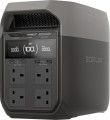Add to comparison |  |  |
|---|---|---|
| EcoFlow DELTA 3 1500 | EcoFlow DELTA 3 | |
from £59.00 | Compare prices 10 | |
| User reviews | ||
| TOP sellers | ||
| In box | charging station | charging station |
| Rated power | 1800 W | 1800 W |
| Peak power | 3600 W | 3600 W |
| Output waveform | sinusoid (PSW) | sinusoid (PSW) |
| UPS function | ||
Outputs | ||
| Sockets (230 V) | 4 | 4 |
| USB A | 2 5В/2.4А 12 W | |
| USB A (quick charge) | 2 5В/2.4A, 9В/2A, 12В/1.5A 18 W | 2 5В/2.4A, 9В/2A, 12В/1.5A 18 W |
| USB C | 2 3 A, 5 A 100 W | 2 3 A, 5 A 100 W |
| Car cigarette lighter | ||
Inputs (station charging) | ||
| From solar panels | ||
| Input port XT60 | ||
| Add. ports | Extra Battery Port | Extra Battery Port |
Battery and charging time | ||
| Connecting an additional battery | ||
| Battery type | LiFePO4 | LiFePO4 |
| Battery capacity | 1536 W*h | 1024 W*h |
| Charging cycles | 3000 | 4000 |
| Charging time (socket) ≈ | 90 min | 60 min |
| Charging time (solar panel) ≈ | 210 min | 130 min |
| Charging power (socket) | 1500 W | 1500 W |
| Charging power (solar panel) | 500 W | 500 W |
General | ||
| Smartphone synchronization | Bluetooth and WiFi | Bluetooth and WiFi |
| PSU | built into the body | built into the body |
| Display | ||
| Carrying handle | ||
| Operating temperature | 0 °C ~ +45 °C | 0 °C ~ +45 °C |
| Dimensions | 398x213x282 mm | 398x202x284 mm |
| Weight | 16 kg | 12.5 kg |
| Warranty | 5 years | 5 years |
| Added to E-Catalog | november 2024 | november 2024 |
When comparing the EcoFlow DELTA 3 1500 and EcoFlow DELTA 3 charging stations, it is noted that both models have the same nominal and peak power (1800W and 3600W respectively), as well as a sine wave output and UPS function. However, the DELTA 3 1500 has a larger battery capacity (30 Ah versus 20 Ah for the DELTA 3), which provides a greater number of charging cycles (3000 versus 4000). The charging time from an outlet for the DELTA 3 1500 is about 90 minutes, whereas for the DELTA 3, it's 60 minutes. It is also worth noting that the DELTA 3 1500 has more USB ports (4 versus 2 for the DELTA 3), but the socket placement on the DELTA 3 1500 is at the back, while on the DELTA 3, it's at the front, which may be more convenient depending on usage. Both devices have similar synchronization features and warranty, but the DELTA 3 1500 is heavier (16 kg versus 12.5 kg for the DELTA 3).